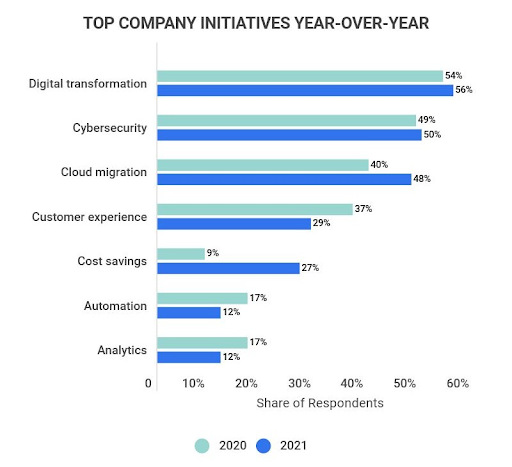Barriers to Digital Transformation to Overcome in 2025
Don’t let these barriers become an obstacle to your digital transformation.

New processes and new technology offer organizations the opportunity to improve performance and efficiency, yet they still struggle to put it together in terms of a ‘whole business’ approach. Understanding the hurdles you must overcome, and the solutions to those hurdles are the first steps to progress. So, what are the main barriers you face in achieving digital transformation as we move into 2025?
Barriers to Digital Transformation You Must Overcome in 2025
You’ll be well aware that digital transformation is now an integral part of the business landscape. Adjusting your processes and systems to embrace advances in technology – such as AI and automation – is essential if you want to compete in a crowded market. While there have been rapid advances across many areas such as tech in recent years, many businesses have struggled to keep up with changes.
Identifying the barriers to digital transformation that affect your business is crucial if you want to move forward. There have been many changes and knowing the best solutions that fit your business is essential. Of course, those barriers may vary between businesses but these are some of the most common you may encounter.
1. Poor Data/Information
One of the ongoing barriers to digital transformation that remains is access to accurate data and information. Only one-third of companies said that they had access to accurate data that could help with digital transformation. Without such accurate data – delivered in a timely manner – it makes it difficult for businesses to make informed decisions and to facilitate any changes needed.
Review how you collect data and analyze its quality. Look at whether you have to implement new methods of data collection and also if new data collection points are needed. If you are facing this issue, it is not something that will be solved overnight but constant monitoring can ensure you are moving in the right direction.
2. Linking Your Strategy to Execution
It’s all very well having a strategy that addresses digital transformation, but how are you linking that to actual execution in the workplace? Many businesses are facing difficulties when it comes to translating their strategies to daily work patterns across their organization. Managers need to formulate a central strategy that covers their entire organization and track progress on how well that strategy is executed.
When you face this issue, it is also essential that the voices of all stakeholders are heard. It’s not enough just to have that central strategy, you should also have regular meetings that include representatives from every department. Having strong links from your C-suite decision makers all the way down to frontline workers can help ensure that formulated strategy connects to actual work patterns.
3. Lack of Experimental Capability
One thing that underpins change is experimenting with new ideas, systems, and processes. Being unable to experiment with these new things remains one of the primary barriers to digital transformation. Not every change will work, but being unable to go through efficient trial and error processes can severely impede progress on your digital transformation.
Don’t be afraid to try new things out; they may be the solutions you have been looking for. Of course, in some circumstances, it may take time to find what fits your business model. However, you should be thinking long-term and looking to achieve peak operational efficiency.
4. Collaboration Across Silos
If people don’t work together, progress will be slow. When your organization has different silos and there is a lack of collaboration and communication, then you will inevitably encounter barriers to digital transformation. When you want to integrate new digital processes across your workflows, you need your IT team to work alongside the other parts of your business.

To overcome barriers, you need to ensure that every silo collaborates efficiently. Ensuring your central strategy is working well, means you need to hear the relevant voices. If collaboration has been an issue you face, consider putting together a committee that has people from each department or utilizing surveys to get your workforce’s feedback.

Optimize your project communication and task management with our user-friendly project management software.
Sign up for free today!
5. Outdated Tech and Systems
A square peg will not fit into a round hole, and trying to adapt to new digital ideas when you are still using legacy systems will always cause issues. That can cover everything from still using spreadsheets to presentation slides. You need to do a full audit across your organization to identify what systems and tech you use that do not fit with digital transformation then update to more modern solutions such as electronically submitting a commercial proposal.
You should also consider where you can consolidate and integrate. For example, look at a modern communications platform that allows for automation where needed but also integration with apps that can carry out and streamline some of your primary tasks. Moving away from all sorts of legacy systems can help you better adapt to existing changes and prepare for any future changes too.
6. Company Culture
Barriers to digital transformation do not only include how we work, it can include who we are as well. Your workforce – from management downwards – is used to working in a certain way and with certain tools or systems. That means they will often be resistant to change. You need to look at your internal bureaucracy and also how empowered all your workers feel.
With improvements in tech and increased use of connected platforms and hybrid working, it’s essential that you shift your company culture forwards. That starts at the top and involves clear and concise communication about any changes being implemented as well as guidance on the new tech, tools, and processes you want your organization to use.
Final Thoughts
Change is never easy and there will always be some reluctance and resistance to adapting to new ideas. But the hard fact is that digital transformation is here to stay and, if anything, will continue to improve (in terms of the efficiency it can deliver) and evolve. In an increasingly competitive global marketplace, it is now crucial that businesses fully embrace that change to keep up with their competitors.
By identifying any barriers to digital transformation that are particular to your organization, you are then better placed to formulate action plans that address and overcome those barriers. The essential thing to remember is to closely monitor any plans you put into action so that you can be sure that the results are moving you forward.
About the Author: Yauhen Zaremba is the Director of Demand Generation at PandaDoc. He’s been a marketer for 10+ years, and for the last five years, he’s been entirely focused on the electronic signature, proposal, and document management markets. In his spare time, he is an avid fisherman and takes nearly 20 fishing trips every year.
FREE 20 MIN. CONSULTATION WITH A PROJECT MANAGEMENT EXPERT
Wanna see how to simplify your workflow with Zenkit in less than a day?
Book a Live Demo
